View current page
...more recent posts
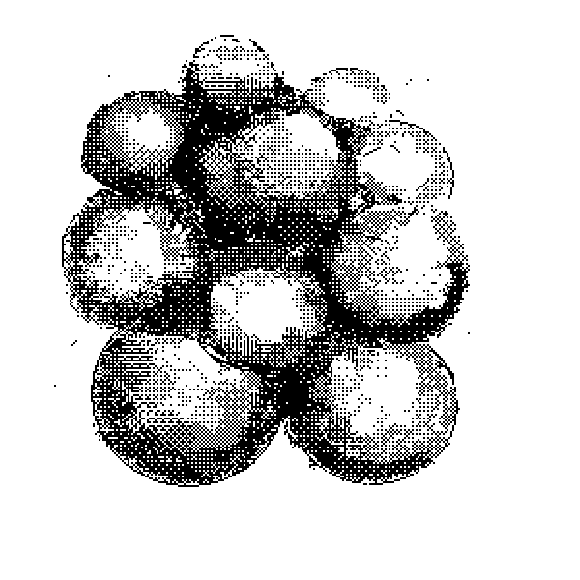
Paddy Johnson on the one art fair this blog would have attended if it had known about it: the Comic-Con, at the Javits Center.
This preference is not because of some chip-on-the-shoulder resentment about the high-falutin' art world so much as a standing revulsion to the idea of having fairs in a city with the largest year-round real estate commitment to art. Every year dealers take work from where it looks the best, bubble wrap it, and schlepp it over to where it looks the worst. All for the convenience of a few uber-mavens who don't want to walk around Chelsea (one supposes). That, and the ultra-distilled odor of commerce that wafts over all fairs, makes it just too depressing for this sensitive artist.
Just checking out Contemporary Home Computing, a webzine by Olia Lialina and Dragan Espenschied, with articles and blogs about our favorite appliance, its metaphors, and its place (or willed absence) in the culture at large. The perspective here is low-res and retro (in a good, non-Ludditic way). Sample article: Espenschied's Where did the computer go?, considering the drive to dematerialize hard drives and screens in the home and workplace, bringing us closer to the Platonic ideal of data as pure light and air. Kind of like factory farming, where meat magically appears in stores in shrink-wrapped cubes and the slaughter and biochemistry takes place somewhere else.
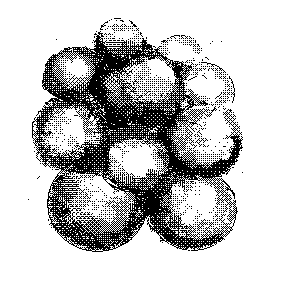
Excerpt from recent post by Juan Cole:
Iraq is an Oil War in the mind of politicians like Dick Cheney. It was necessary to deny it to China and other rivals thirty to fifty years in the future. It was necessary to open its vast petroleum fields up for exploration and cast aside anti-American Baath socialism.("3 Boxes" GIF by Jack Masters or Kasey Kite returning soon.)
Likewise, the religious rigidity of the Pushtun peoples of Helmand province is not the real reason for the US insistence on occupying Afghanistan. It is the vast Turkmenistan and Uzbekistan gas fields that Cheney has his eye on. It was the US hope to use a pipeline from Turkmenistan to supply Pakistan and India, and so forestall a deal by those two countries with Iran. The inability of the Bush administration to calm things down in Afghanistan sufficiently for anyone to dream of putting in such a pipeline and having it avoid routine sabotage has made it likely that Iran will break out of the Bush boycott toward the East.
Hunger for future rights to petroleum and positioning the US to remain a superpower in a world of hydrocarbon scarcity is also driving the campaign to get up a war against Iran. Why can Pakistan have a nuclear weapon, and that is all right, but Iran cannot? Pakistan has very little petroleum. Iran has a lot, and maybe 750 trillion cubic feet of gas in the southwest. If it gets a bomb, regime change becomes impossible, and if Iran wants to tie its supplies up in proprietary contracts with China and India, locking out the United States, it will be able to do so.
Continued heavy dependence on gas and oil therefore not only turns the world into a hothouse, with rising seas, ever more destructive hurricanes, and possibly disastrous shifts in the ocean currents, but it also drives the United States to more and more wars.
And, note that the wars are not even successful in allowing a practical oil grab of the sort Cheney and Lee Raymond dreamed of.
Indeed, you could now, in retrospect, turn their whole argument around on them. US militarism cannot secure petroleum and gas supplies from places such as Iraq, because the pipelines are so easily sabotaged and local nationalisms and religious activism make it impossible for people to accept that kind of US hegemony.
Since the Pentagon cannot practically speaking hope to safeguard US petroleum supplies from the Gulf, national security requires a massive and rapid research and development program of green energy. A lot of green technology, especially solar, would come down in price rapidly if enough government money were thrown at it. We need to press Congress on this, and maybe Californians can craft some of their famous referendum items. That would be one way to promote a new generation of electric cars.
Green energy-- wind, thermal, solar, maybe ultimately fusion, etc.-- is what would allow the US to retain its autonomy and independence into the next century, and what would allow it to avoid losing more cities the way Bush and Cheney lost New Orleans. Oil and War will, in contrast, ruin us all.
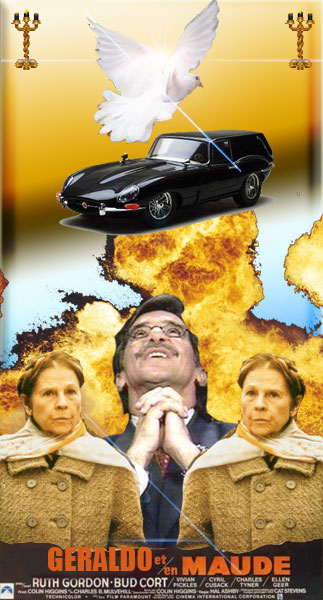 by pupsintrouble, from an idea suggested by jmb. The ascending, Renaissance altarpiece-meets-celebrity-shrine feel of this amuses--also the bad Photoshop gradients, European film poster source, doubling of Maude, pious Geraldo, tabloid explosions, fetishized Jag-hearse, gratuitous gleams... It's funny on many levels. |
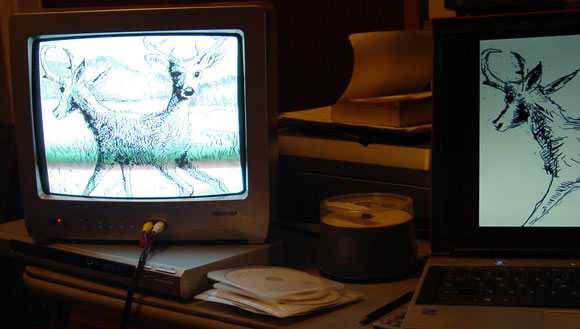
A DVD version of my YouTube drawing demo. The quality of the photo is lousy, but quality is sort of not the point here. *** Last night I dreamed I rented a car and took it out on the highway. I pulled over on the shoulder, got out, and stood by a wire mesh fence perpendicular to the road. A woman was standing on the other side of it. She had also parked on the shoulder and was talking incessantly into a cell phone. I started banging/strumming the wire mesh, which made interesting, peculiarly resonant noises. I got really absorbed in it. I wondered if the woman could hear them but she seemed oblivious. I walked back to the highway and saw a cop car pulling onto it after stopping where ours were. I looked for my rental car and couldn't find it anywhere--it had been stolen while I was standing there. |
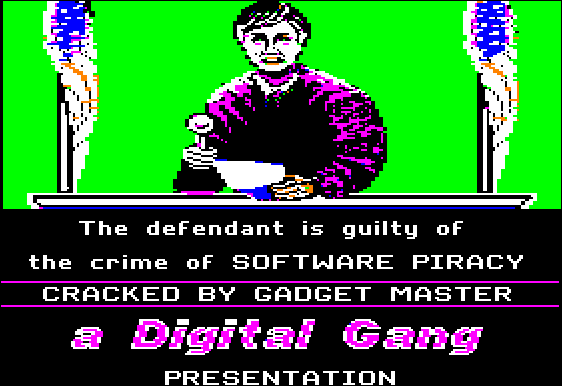
image via Kasey Kite
Seymour Hersh in the New Yorker explains the shifting dynamics behind our hating al Qaeda-promoting countries and helping Shiites to reversing that depending on whether the country or ethnic group in question likes or hates the current purveyor of absolute evil, Iran. Saudi Prince Bandar (aka "Bandar Bush") is once again actively involved with American foreign policy making, you might be interested to know. It's good to understand what's going on as we prepare to launch a war (just a little one--air and sea) against the Iranians. What--you think President Cheney won't do it? You think Congress will stop it? Ha ha ha ha.
Impeach, ASAP. Then impeach Congress.
A great mp3 blog I've been following has been offering whole LPs for download as .rar files. The content is obscure prog and postpunk gems from the 70s, early 80s mostly. Obscure as in...extremely limited releases, cassettes, some major label product that hit the cut out bins six months after it came out. The blog offers extensive research notes, cover scans. It's a labor of love, but the Internet doesn't always appreciate love, and this recent post makes you say "ouch":
Till now i was laughing at all these offensive comments ,but i'm really tired of this situation.My purpose creating this blog was not to read offensive comments.Just silly romantic i just wanted to create somekind of community to spread music long forgotten and obscure.But it seems some assholes does not like that.Possibly i'm making their valuable items for sale cheapier, perhaps they didn't ever realise that music is not their property ,perhaps they are just silly jealeous.I don't know... But under these circumstances i started thinking of closing the blog down...this is not something decided...just a thought....i know ,they are possibly happy,possibly their purposes are achieved....but i do not intent to leave this blog take my whole life and make me nervous and upset...i started with good purposes....but ...i don't know...no posts for the next 2 days...i just wanna think and decide....A big thank to all supporters...at least i found some friends here... [...] ...sorry if i have forgotten some it's not done by purpose...i'm very upset right now to let myself think clearly...thank you all guysUpdate, Feb. 27:
After this real big amount of comments and deep thought i decided that it would not be fair by my side to close this blog down.So we keep on mutating!With 2 new contributors now and hope more to be added soon!And by next weekend everything will be on mediafire.I will try to keep my posts in a limit of 3 or 4 per day.For people complaining for mistakes:i track every single complain down and as soon as i got time all these will be fixed. I had ,due to family bussiness, not to be on my PC yesterday and today it was a very hard work to moderate this vast of comments.And big pleasure perhaps.Thank you all guys for your support and i'll try to do the best from my side.It's really amazing to get support from too many people you do not even know in person....We are a community:) A Mutated community...We keep on mutating!
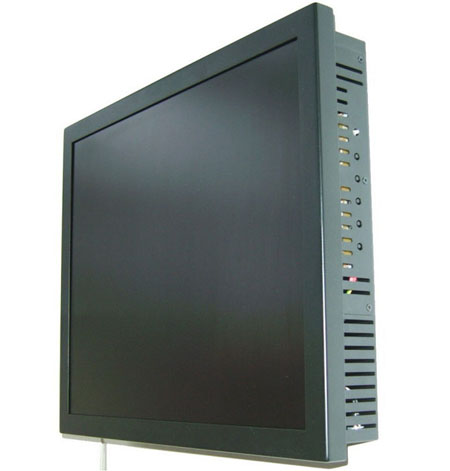
Following up on some earlier posts about showing new media work in the gallery and digital non-sites, here's some recent writing on gallery friendly hardware set-ups, for art that absolutely has to be shown on a computer screen (as opposed to DVDs). Olia Lialina discusses the "Torch" brand of screen-with-built-in-computer here. I still have some questions about that device (photo above), asked in the spirit of being open source:
--The website says there is no hard drive for the slim computer--how is the data stored for a piece?Many of these same issues are raised and answered with respect to a Mac Mini or PC setup in this post Showing Video via Computers by artist Paul Slocum, who is also running a gallery. It's very thorough and helpful even though it makes me want to stick with just popping a DVD in a hundred dollar player and dealing as an artist with the compression artifacts. It's a lot to ask a harried gallerist to memorize this how-to and/or constantly go yourself to the space to see what's wrong with the computer. Especially for work that anyone in the world can see displayed perfectly well on the Internet, at home. But that's just me ducking responsibility--artists are obviously coping with these issues.
--Why do they have all the USB ports and such? It looks like an awful lot of computer just to run GIFs (or whatever programs are providing content for the screen). When I saw Lialina's work at Bryce Wolkowitz gallery I assumed it was some kind of flash memory built into the screen.
--Doesn't it have an operating system that has to boot up each time it's turned on, and then a program on the operating system to run the GIFs, all accessed by hooking a mouse and keyboard to the ports on the computer? Can it run without Windows XP, which Torch describes as "optional"? (Lialina says via email that hers was Linux and there was no boot screen. Linux--aiee!) [update--some answers to these qs below]
Update: Some late thoughts. That Torch Computer screen is elegant in person, very generic, and I like that they deliberately made it without a logo anywhere visible. I'd like to own a few (once I get my mundane practical questions answered), and I think it would be a good investment for galleries that show new media art on a regular basis to own a few. I would even like to see it be something that collectors buy. My questions are aimed at making some kind of "display lingua franca" that everyone is accustomed to using for certain types of work. As opposed to reinventing the wheel with every show or making the show be "about" what major corporation's hardware you are plugging. I believe that is what Lialina is proposing in her article.
Update 2: Paul learned the following from Torch: "19 inch LCD screen, 1280 X 1024 resolution, with built-in mini-ITX computer...with built-in 1GHz CPU, 256MB RAM. There are two versions of this. The Linux version comes with a flash memory of 1GB and operating software that reads a web page from a USB pendrive, also supplied, that is displayed on the screen without any visible indication that it is a browser. That is, there are no visible frames, scroll bars, menu bars, tool bars, etc. This version is priced at 595.00 pounds ($1169). The other version is supplied with a 40GB hard disk drive and Windows XP Home. This is priced at 665.00 pounds ($1307). All prices exclude shipment charges, duties and and taxes." (As Paul notes, shipping and taxes for the cheaper of these UK products could be $300-600 to the US. They are custom-made and take 4-8 weeks to prepare.)
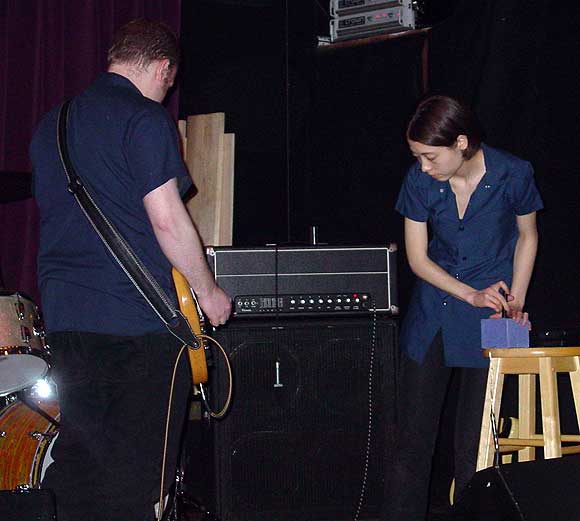
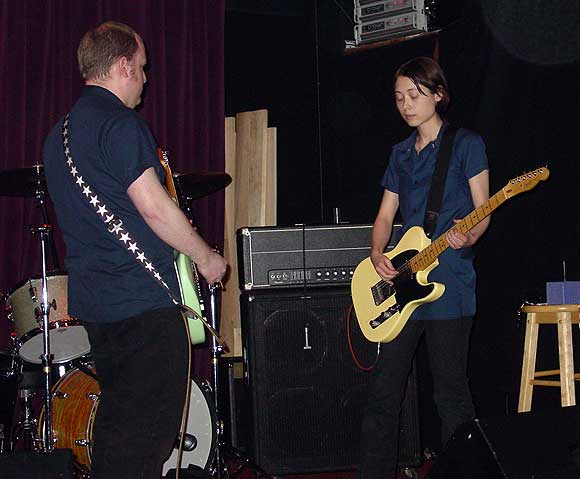
Neg-Fi live at Union Pool in Brooklyn, last night. In the top photo Evelyne works the Neg-Box's sole lever; the bottom shows Ryan and Evelyne in characteristic stage posture for most of the songs, which are short metalloid guitar duets. Imagine a No New York-ish riff stripped down to a few bars, straight up, loud, for under two minutes. The riffs are all good--"Neg OK" and "NegButter" on their MySpace page give you the flavor if not the volume.
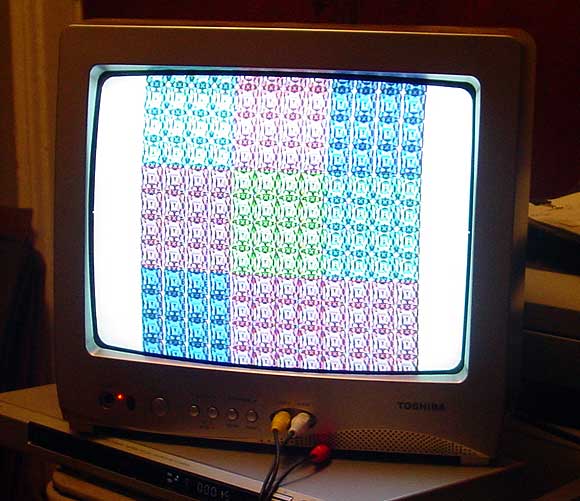
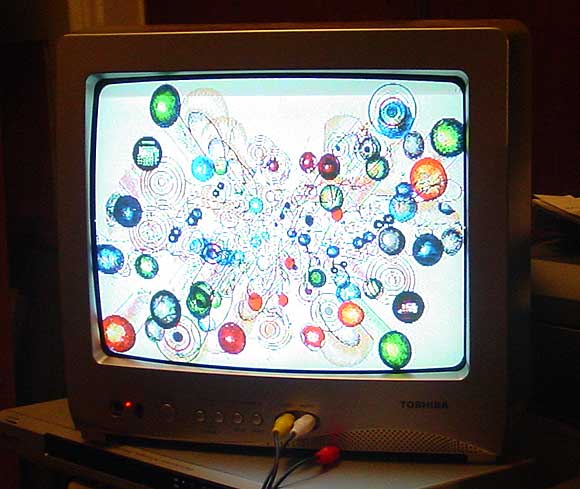
Working on some video pieces. I like/hate this medium. Like it when it's the right balance of clumsy and novel but hate that you can so rarely get that. The top piece is that html grid of jewel GIFs I keep posting, captured off the web--about 15 times--each capture is a different sequence and then the best (most fluid) sequences are edited roughly in time to the music piece I wrote. (I reposted the Quicktime .mov, which gives an idea.) I had to redo this yet again last night because my captures weren't consistently cropped. I wanted the "shaky GIF effect" to happen entirely within the boundaries of the piece. The bottom piece is Vortex 2, which I showed in Mobile, AL last fall. I have no idea what it looked like in the gallery so I made my own installation shot.
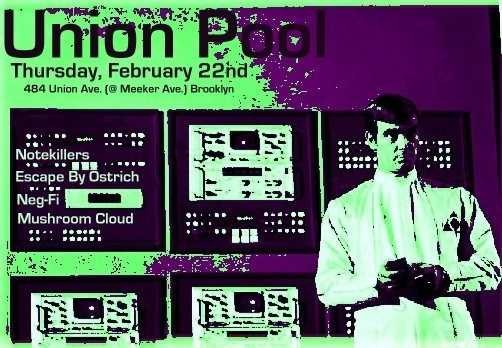
Thursday, February 22nd, 8:30pm (doors), Union Pool, 484 Union Ave (at Meeker), Brooklyn, $8
9 pm - Mushroom Cloud
9:30 - Neg-Fi
10:15 - Escape By Ostrich
11:15 - Notekillers
From Neg-Fi:
"Debut of our first LP release "Listen-OK!"- features most of the songs we've been playing as part of our live set the past few shows. Available on LP (limited edition of 200) and cdr. Also available for the first time will be a cdr collection of some older material culled from our cassette and other releases called "-1 and other big numbers."
My description of a Neg-Fi talk at Dorkbot:
"In the '50s, a time of postwar optimism and faith in science, there was Hi-Fi. In the '90s, an era of slackers and diminished expectations, there was Lo-Fi. In the '00s, a time of neanderthal government and outright contempt for the arts, there is Neg-Fi. A watershed moment in the history of art and music--some might say sub-nadir--was reached tonight when this New York noise-rock duo demonstrated its Wireless UFDs (uncontrollable feedback devices) to an audience of 100 or so at Dorkbot-NYC. Walkie talkies from the dollar store have been reinstalled in custom cardboard cases. When placed in proximity to each other and turned on, they make squealing and static noises. And that's about it!"
I've been enjoying the diverse selection of material on the Neg-Butter mini-CD--it's low-key noise rock/electronics but not unmusical by any means. (Note double negative.)
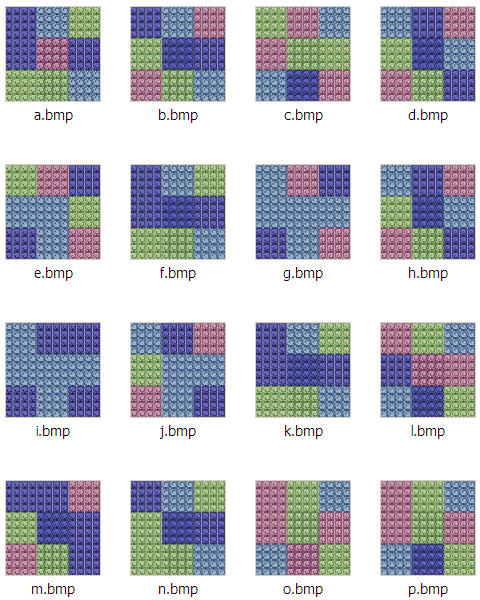
Today is the sixth aniversary of this blog. Thanks to anyone who has commented, linked, or relevantly emailed. This feels like a group page even if no one else has Wiki-like editing powers. OK, enough sloppy sentimentality, let's get back to work.
Update: A longer "looking back" post was written and scrapped as too self-indulgent. The only reason this update is being added is to provide a bit more of a text buffer between the preceding and following images, for design reasons.

MySpace page logo from Neil, excellently interpreting this earlier post. Neil says he'd like to meet fakeisthenewreal.
Update: Neil has revised the page to state that he is fakeisthenewreal and who he'd like to meet is you.
"Big Rock Grid" (audio only) [mp3 removed]
Update: I had a Quicktime .mov with this as a soundtrack but the file size is too large for my lo-fi standards so I pulled it.
Update 2: Here is the screenshot for the .mov. I may put the file back up if I can find a politely amusing way to explain the exorbitant download time.
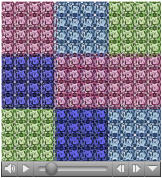
Update 2: I've edited the .mov [converted to .mp4] to pick up the pace a little bit. I have also made a DVD of this video on a bigger scale that plays on a CRT, so this is a thumbnail version of that with full sound.
"Big Rock Grid" [12 MB .mp4]
thanks to mbs for finding the site full of big rocks (jewel GIFs)
"Steady State Funk" [mp3 removed]
I believe this to be a "killer riff." You could probably dance to it!
Enjoyed the first season of HBO's The Wire (thanks, S), but stopped watching Season 2 partway through the DVD box set. Reasons:
1. Ziggy. (Uggh)
2. The Greek and his crew. So many ominous silences, so much meaningful espresso-sipping.
3. Not enough Omar.
4. Too many characters recycling moves from first season.
5. Stevedore makes philosophical speeches about the decline of unions--eloquent but too writerly to be believed.
6. Last but not least--two union guys want to find out more about the chemicals The Greek is smuggling in shipping containers they handle, so they go to the public library and use Microsoft's Live Search.

Kristin Lucas, Travel Advisory, 2007, lightbox. Featured in a show opening in about an hour at Postmasters, 459 W 19th Street, New York, and running through March 17 (Gallery 1: Eva and Franco Mattes [a.k.a. 0100101110101101.ORG] are showing "13 Most Beautiful Avatars," and in Gallery 2 it's Lucas, Jennifer and Kevin McCoy, and Wolfgang Staehle). The Creeping Unknown is back, but it's OK, it's been normalized.
Update: this image has not been reBlogged or picked up anywhere that I'm aware of. Possibly because it does not "make people feel good" which is an important part of art practice.
The US Senate is still scared of Bush even though the President's popularity numbers are in the low 30s. They can't even muster the votes for a toothless resolution on the Iraq War escalation, despite the clear will of US voters expressed last November. Supporting the troops means getting them out of there, you numbskulls, not letting Bush kill them. I believe I speak for the majority of Americans in saying, I don't trust Bush, why do you? (Answer: smear merchant Karl Rove has pictures of all of them in their underpants.)
A post from MyDD, minus the links, on the current Balkanized state of American cell phone networks, giving us a glimpse of a what a non-neutral Internet would resemble:
Matt's mentioned Tim Wu's most excellent paper on the American wireless scene twice now, but I don't think this horse is dead yet. Wu paints a nice -- and by "nice," I mean kinda horrifying -- picture of what an Internet missing the fundamental principle of neutrality might look like. Take, for example, the state of innovation in the cellular market. Here in the U.S., wireless carriers rule the roost. They control what phones hook up to their networks. Since equipment developers have to design for particular networks, carriers pretty much control their entry into the market. Carriers lock phones to their networks and cripple [them on] neat technologies like Bluetooth, wi-fi, and even call timers (so as not to have you compare your records to theirs). Couple that with no real standards for software development, and few people bother building exciting new cell phone apps. To get a snazzy new iPhone you have enter into a contract with AT&T/Cingular, which is roughly analogous to Apple telling you that your new MacBook won't go online unless you switch to Comcast. The way wireless works today, innovation is only tolerated if it benefits the carrier, not the consumer.
Wireline (you know, when phones have wires) is of course pretty different. Yeah, the landline phone companies once argued that it was technically necessary for theirs to be "totally unified" systems. But today we can hook up just about any device to a phone line -- like, say, a modem -- because we were smart enough to enshrine the idea of open networks into law.
Over at the Agonist, Ian Welsh has more on the American wireless landscape, written in sort of fairy tale prose. Whatever it takes. In convincing people of the dangers of a carrier-controlled Internet, I think we could do worse than to get them to reflect on their own personal experiences as cell phone consumers.
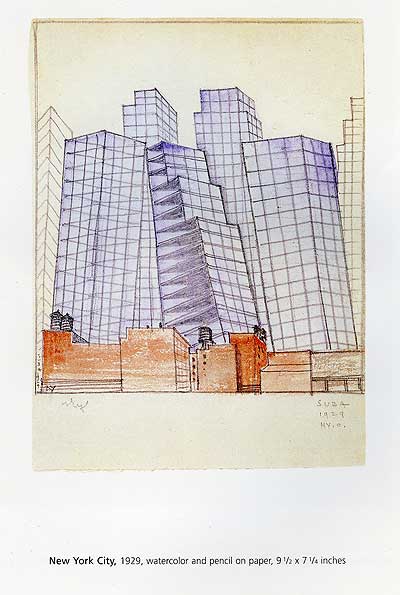
According to Grace Glueck (recently departed the Times because...why again, exactly?), Miklos Suba was a minor Precisionist whose specialty was Brooklyn cityscapes rendered fairly scrupulously. He wasn't a fantasist by any means. So what could have been happening in this picture, which will be shown at James Graham & Sons next month? Did buildings like this exist in 1929? Was the artist clairvoyant? These purplish towers could be the monster glass vanity projects lumbering into present-day Brooklyn.
A 2 MB GIF built from screen-captured stills of the image in the previous post is here. It's only 16 frames so not as complex, but it moves faster and might give Safari users an idea of what the grid looks like in Firefox/Netscape/IE. As I understand it Safari, alone among browsers, does not load animated GIFs in sync, so you get random clumps of synchronization depending on which GIFs load first. This would not be a desirable effect here. Safari also fuzzes out GIFs when you use HTML to scale them up, under the assumption that the only imagery ever used on the Web is photography, which benefits from smoothing. Why do Steve Jobs' designers hate lo-fi artists?
not intended for RSS readers
Update: A 2 MB GIF of this grid is here. See next post or comments.
Cat Bus YouTubes by Anthony Leslie (aka CatBus4U):
#1
#2
#3
#4
All are great--my neighbor Totoro meets Paper Rad meets your 3rd grade nephew with compression-mushed MSPaint pixels in lieu of vector graphics. And great sound. YouTube commenter Chuck2dun is stingy in his praise, however: "At second 'three' [of vid #4] where you have the cat turn its head INSIDE the unchanging head shape is very good. The effect is arresting. I also prefer the black and white to the color. Have you thought about using lower chroma colors?" (hat tip guthrie)
"Tesseract Ranch" [mp3 removed]
My contribution to the tech house genre. This is all live hardware sequenced (no overdubbing) with some EQ and reverb added after the fact.
Update: I substituted the "dry" mix of this--no EQ or reverb. The effects were "bodying up" the sound at the expense of some of the DSP nuances.
1987 - Chris Burden's All the Submarines of the United States of America
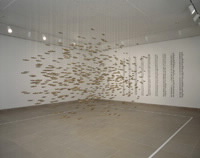
2006 - Fiona Banner's Parade
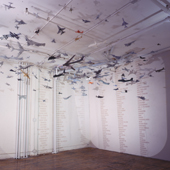
Thanks to Sally McKay for making me aware of Banner's collection of modeled fighter aircraft from all over the world, which will be shown soon in Toronto. It's the latest in our ongoing "attack of the clones" series.
Updated re: installation schedule.
"Tesseract Farm" [mp3 removed]
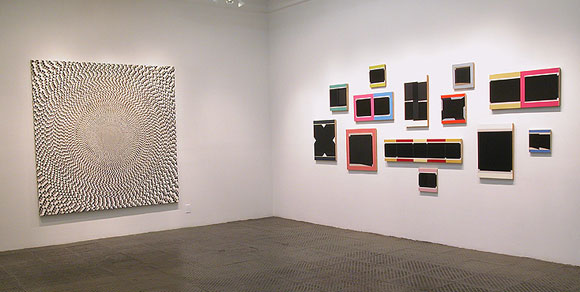
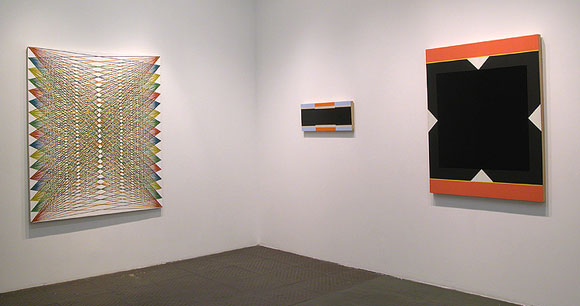
I am going to see this show later today--Mark Dagley (left images) and Don Voisine (right images) at McKenzie Fine Art, 511 West 25th Street in Chelsea. It's the last day of the exhibit, sad to say. An earlier post on Dagley is here. This current show with Voisine is reviewed in the New York Sun--nice, but I wouldn't stop with physical analysis of the work. Doesn't it look like Voisine is censoring his own paintings?
Update: one invigorating thing about the Dagleys in person is the Stella-esque what-you-see-is-what-you-see quality. The bottom one has a white ground and each line is a thick painted stripe connecting two points. The top one is thousands of circles drawn by hand in pencil and then filled in. It's a weird combination of cabalistic arcana, prison art, and the Bauhaus. As much as I enjoyed Marc Handelman's show at Sikkema Jenkins (a Bleckneresque young Turk out of Columbia who has all the advantages of art world virginity) it seemed flashy and overeager to please compared to Dagley's work, which is dazzling yet unassuming, and not as conservative as our two world weary critics might consider it (you know who I mean). As for the Voisine, Mark used the word redaction in the comments and that is the first thing the black bars bring to mind, even though in person you see a play of edges and surfaces in all those blacks. I'm personally not uncomfortable with references to office/bureaucratic culture in art and feel like the self-cancellation of those Xs and black bars gives the work an interesting psychological edge, though it was probably not intended--the paintings are handsome and thoughtful but serious about the rhetoric of painting.
The panelists for an upcoming College Art Association discussion on "Emerging Artists, Critics, and the Market" are Jeffrey Deitch, Don and Mira Rubell, Peter Plagens, and Jerry Saltz. According to an email from AICA, the critics' association organizing the event at the Hilton on Feb 17, among the questions to be addressed are:
In the current situation what, indeed, is the critic’s role and responsibility? Are there opportunities? Are there ways to respond and to act that circumvent the conventions of build-a-reputation/trash-a-reputation? What is the relationship between collectors and dealers? How does it work? Why do art world systems go unanalyzed and uncritiqued by most critics? Is there room for critics to deepen the discourse? If so how? Does it make a difference if critics expose the issues within the market, art-making and criticism? Is anyone listening? Can dealers, collectors and artists listen to critics or only to one another? Is there anything critics learn from collectors and dealers? Does it matter? Are artists so caught up in the dazzle and anxiety of early success that they can’t hear what they have to know or should a critic attempt to reach them with reasoned argument?
I quit going to these types of panels after a prominent critic told me "we can't discuss specific artists because collectors will rush out and buy them up." Here is an alternative set of questions:
1. What new forms of art have emerged since the '70s? Who are the best artists working today?
2. Have we had a "brain drain" in the art world since the days when Leo Steinberg, Rosalind Krauss, and Craig Owens wrote about their contemporaries (i.e. since about 1982)?
3. Is the art world's dedication to a relative handful of canonical (i.e., marketable) artists comparable to the "copyright tyranny" of Disney and other large corporations?
4. Won't blogging and other forms of online writing largely replace print criticism in the near future? (The publisher of the New York Times seems to think so.) How will that change art practice?
Update: Added Timesman's prognostication and link.
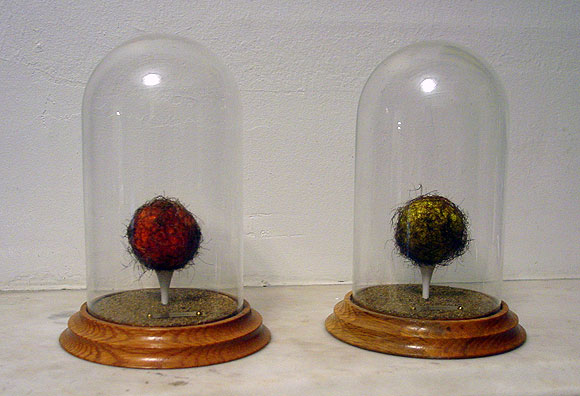
A work from my personal collection: The Art Guys' Goatee Off, ca. 1990. It's documentation of a performance piece where the Houston-based artists grew goatees and played a round of golf, shaving bit by bit as a way of keeping score (go tee off, get it?). Their beard hair is what you see glued to the golf balls. Meret Oppenheim, drink your tea.
Continuing our Art Guys series, this is a review I wrote for Art Papers when I lived in Texas and never sent in because I couldn't make it work...until today. It's a bit late for the magazine's deadline so here it is online:
"Jets," by The Art Guys
Dallas Museum of Art, November-December 1991
The main concourse of the Dallas Museum of Art ascends in a series of broad, gently sloping ramps, creating spaces reminiscent of airport architecture. Appropriately, that's where the Art Guys placed their installation Jets during the 1991 Dallas Video Festival.
Sixteen TV monitors fanned across the ceiling over the ramps, linked by black cables to a neat bank of VCRs on the wall. Each monitor faced down with its back securely bolted to the ceiling--or so we hoped. The screens glowed pale blue, green, or violet, the ambient colors of footage taped from the sky at different times and places, and intermittently roared to life as an airplane passed across the screen.
The artists phased the tapes so at a given time some screens showed empty sky and others tracked commercial aircraft landing or taking off in wobbly, hand held fields of view. The random distribution of the zooming images along the corridor kept the viewer off guard: as you followed the progress of one jet, another would loom unexpectedly behind you.
The network of cables crawling across the ceiling and down the wall to a controlling ganglion could emblematize the global transportation and communication systems on which we are so dependent, while the fragility of the systems could be felt in the nervous-making Damoclean placement of the monitors. That's one level of interpretation.
Yet sitting beneath them for a few minutes revealed something a hurried passerby might have missed: their curious kinship to natural phenomena. The random lightening and darkening of screens and the antiphonal whining of the jets became paradoxically calming, like stars blinking or insects chittering in the breeze. Thus do our daily threats become reassuring background texture.
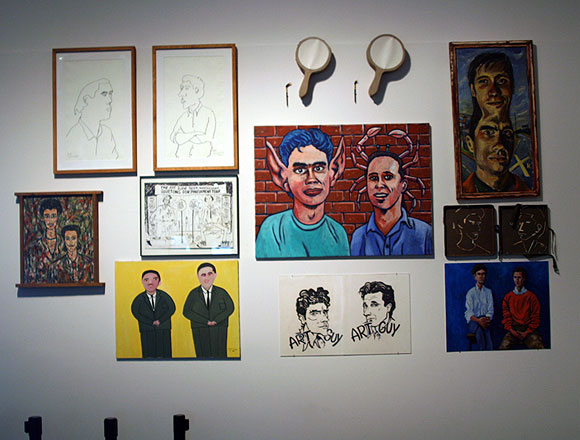
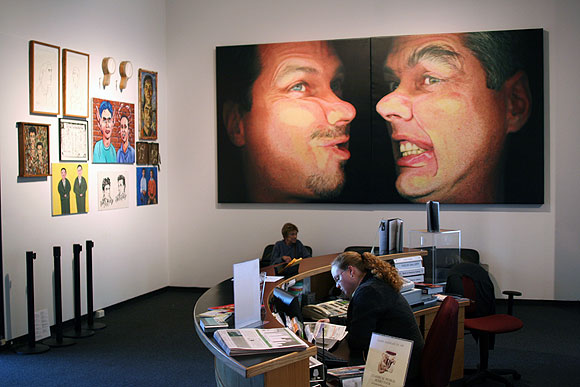
Third installment in The Art Guys series, these are photos from their current survey exhibition at the Tampa Museum of Art. The cluster of portraits originally came from a show they did in '90 called "See Through Us," an open call where other artists were invited to render them in various media. As a participant I tried to be as thift store painting-like as I could, hence my canvas of Michael Galbreth with oversized Mr. Spock ears and Jack Massing with crab appendages sprouting from his head (look, I'm in a museum now!). Although the painting above and to the right of it with Jack's face growing like a wen from Michael's forehead is far more successfully "thrifty." The tasty installation of these paintings is by Jade Dellinger, who curated the show. On the right in the lower photo is Smushed Faces, 2000, printed vinyl.
























































































Mood Ring, 2007, GIFs, HTML
Not intended for RSS readers.
"Abstract Thinking (Photons)" [mp3 removed]
Another variation of this piece, incorporating a special effect sound from, let's just say, a popular televised science fiction drama. There is now an added "tripped out" middle section with some layered sputtering LFO noise and a snare run through an effect-pedal octave sequence.
Update: Added a new synth part to this. I think I'm still working on it (see comments).
Update 2: the piece is pulled for further tinkering. When it rises Phoenix-like it will probably have a new title.
Update 3: Or not. I put it back up, with the original, underlying synth tracks all sliced up and made to obey the meter.
































































































































































Untitled (Chris Ashley), 2007, GIFs, HTML
Not intended for RSS readers.
At the Whitney Museum coat check, I swear my recollection is they just take your bag and give you a plastic chip. At MOMA they make you open your bag, ask you about the contents, and reject certain items! Here's how a recent visit went down:
"Sir, you have to open your bag."
"You're kidding. OK, check it out. There's a scarf in here, a music software manual, my Daytimer..."
"What's in that pouch?"
"Checkbook..."
"I'll have to ask you to carry that."
"You're kidding. Say--when did you start doing this, interrogating people about their bag contents?"
"I've only worked here six months but" (eyes widening) "of course all bags have to be inspected since 9/11."
"Yeah, right, but that was six years ago!"
At this point some tourists were looking over uneasily, wondering what the "scene" was about.
Thanks, MOMA, for setting a friendly, contemplative mood at the entrance to your museum.
































































































































Memo to Gary Hill
Re: Your Show at Barbara Gladstone
The giant CGI animatronic eagle angrily flapping its wings and making power lines crack like bullwhips in multi-channel surround sound appeals on some goofy level, but the lake of crude oil you placed in front of it with the gold bullion in the center takes us into the realm of metaphor fatigue. Thanks for telling us via the press release that the piece was about the US occupation of the Middle East. The guard in the gallery barking at people when they get near the work is not too cool, though. Especially when it's a sheet of black, glassy-smooth oil in a semi-lit room that you might want to look at closely, if for no other reason than to see if it's as much like Noriyuki Haraguchi's work as it seems.
And if you must place telescopes around the space, you might want to aim them at something besides those custom gold coins of your grimacing face "undergoing fictive scenes of torture" that are placed on spotlit sculpture stands in the same room--it seems redundant, and not in a good way. Again, it's nice to have the press release handy to tell us that your installation, "through its use of the metaphor of market exchange, distances the true act of brutality, even when the acts of surveillance bring it so close the viewer's body." We're worried about the war, too, and thankful that a festival artist such as yourself has a big gallery to get the message out.
Update: Breaking: The real reason for the guard was that gold bullion--one of the ingots was just stolen from the Fondation Cartier version of this piece. See the comments to this post--thanks, James.
Paddy Johnson unfavorably reviews Doug Aitken's outdoor video installation at MOMA, Sleepwalkers, today in The Reeler. As usual she is good at exposing the fatuous reasoning behind a piece--in this case the decision by MOMA, Creative Time and the City to host it in the dead of winter so it will be a tourist draw like Christo's Gates*, a loser if ever there was one for art you aren't walking through at a brisk stride but are presumably expected to stand and watch--but I still have some questions about it. I need some more reasons to get off my ass and go (or not). Maybe she can elaborate on her blog [update: responses here]:
1. If the piece is supposed to be about a day in the life of ordinary New Yorkers, isn't that ruined by using celebrities such as Cat Power, Tilda Swindon, and Donald Sutherland, in the roles? If Aitken wants to flout the conventions of cinema, why use movie stars? Is Sutherland's "dancing on top of a cab" something ordinary people do, or only Michael Jackson?
2. Isn't a "non-linear narrative" the ultimate art world cliche at this point? What does this piece do to surmount that?
3. How do the moving images on sides of buildings differ from the corporate displays a few blocks over in Times Square?
*Sourced to an anonymous MOMA employee, but no one Johnson spoke to seems to have actually denied it.
"Abstract Thinking (Quiet)" mp3 removed]
Some of the subtle moog-y stuff was lost in all that din.
































































































































































variation
"Abstract Thinking" [mp3 removed]
Caution: loud, we're talking Ricky Martin loud. I took a few beats from Brains' remixes of my earlier tunes and made some of my own so this tune would bang.
If you happen to be in Scotland tomorrow, please check out the show below. My animated GIFs will be projected 22 times in a line of screens running down a long wall. Earlier I posted a prototype showing how it would work with 4 screens (Double Centrifuge GIF x 4, test of multiple versions: [65 KB Quicktime .mov]).
Fresh NY
Alisa Andrasek, Michael Bell-Smith, Brody Condon, Brent Green, Tom Moody, Takeshi Murata, and Prema Murthy
guest curated by Anne Barlow
New York comes to Perth on Saturday, 3 February 2007. The meeting point is Threshold artspace, the contemporary art gallery at the threshold of Perth Concert Hall. The occasion is Fresh NY--an exhibition which showcases seven of the most exciting young artists working with animation and digital media in the New York region--most of whose work is being seen in Scotland and the UK for the first time. Fresh NY's guest curator is Anne Barlow, a Scot based in New York, previously at the New Museum of Contemporary Art and just appointed Executive Director of Art in General – one of New York's leading not-for profit arts organisations.
"Reflecting current tendencies in contemporary digital art," states Barlow, "Fresh NY includes an intriguing mix of projects, from beautifully crafted animations to hypnotic, computer-generated visuals, and work inspired by gaming culture”.
The public preview of Fresh NY also compliments Bang on a Can--New York's electric chamber ensemble who performs in the concert hall throughout the day including music by Stephen Reich, Philip Glass and Brian Eno. After the all day long public preview, the works featured in Fresh NY will become part of the Threshold artspace collection and shown regularly as part of the daily programmes.
More about the works in Fresh NY
Brent Green, a self-taught animated filmmaker, presents Hadacol Christmas, a strange and haunting story about Mr. Claus who is addicted to Hadacol cough syrup. While aspects of Green’s work conjure up early Walt Disney drawings, the dark animations of Tim Burton, or Appalachian folk-tales, this short film remains a highly personal production.
Together with Green, the artists Tom Moody and Michael Bell-Smith share a love of the 'lo-fi”, but their influences come more from their immediate 'graphic landscape' of mobile phone visual displays, urban media screens, and web page advertisements.
Tom Moody proudly creates low-tech art with standard off-the-shelf products such as simple paint programmes, photocopiers and consumer printers. The Threshold Wave goes franticly busy with Moody's tiny animated GIFs now scaled up to optical art proportions. Moody belongs to a current generation of artists, who use those twinkling and often irritating image files that draw your attention on a web page, known as GIFs, in playful or ironic ways.
Michael Bell-Smith also operates in the gap between 'smooth' or low-tech aesthetics; animated cartoons and painting with unusual effectiveness Much of his work is created by sampling and manipulating images from the Internet. As part of Fresh NY he presents Some Houses Have Pools – a dreamlike aerial view of an endless suburbia, devoid of any specific narrative. Bell-Smith's main concern is color, space and light, tweaked and amplified by digital technology and restrained animation.
Alisa Andrasek's work The Invisibles makes its debut on an extra large scale at the Threshold Wave of 22 screens. It consists of swirling and mesmeric 3D cells scripted in animation software. Andrasek, who principally works in the field of architecture, is interested in creating what she calls a “pattern intelligence” – which can be applied to surfaces and forms in architecture, design, and fashion.
Takeshi Murata pushes the boundaries of animation and psychedelia with sophisticated code-based image processing. Recreated as a hypnotic 22 screen installation Monster Movie is one of his most celebrated video work. Its lead character is a B-movie Yeti who decomposes and reconstitutes thirty times per second, becoming a seething, digital morass of color and form. “Murata’s particular genius is an almost alchemical ability to transform forgotten relics of pop culture into dazzling jewels” comments the American art journal Artforum.
Brody Condon's widely acclaimed work Karma Physics < Elvis is a tongue-in cheek, self-playing version of the popular computer game Unreal 2003. As the viewer's camera floats through an infinite pink afterlife, multiples of Elvis are controlled by 'Karma Physics' – the original game's engine used to simulate realistic game character death. Condon's work represents a highlight in the art games series showing on the Threshold Stage all year round.
Prema Murthy uses numerical information and video as a sculpting tool. As part of Fresh NY the artist presents an especially re-worked short film starring some of her strange creatures. The bodies integrate and disintegrate according to their fluctuating data values. Murthy's tool is a 3D modelling software programme and her skills involve sifting through tons of digital data such as immigration patterns, effects of global warming, and consumer spending.
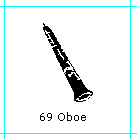
Didn't listen to all the entries in WFMU's sixty second song contest but this version of "In-a-Gadda-da-Vida" by Stiever deserves a vote [very small .mp3]. Another keeper is Otis Ball's "More Than Half-Off-Bird" [another small .mp3]. The "strategic cut of death" pieces are preferable to the obvious mashups and speedups.
